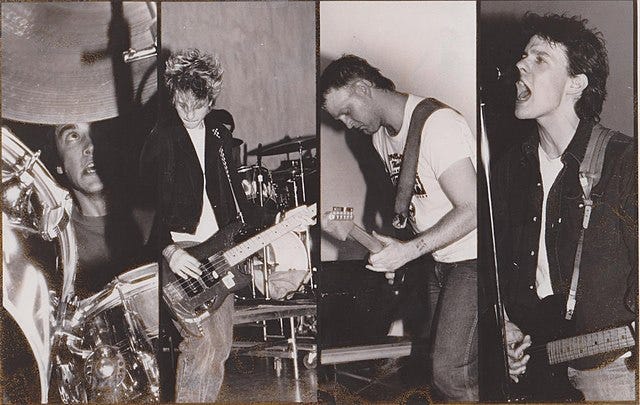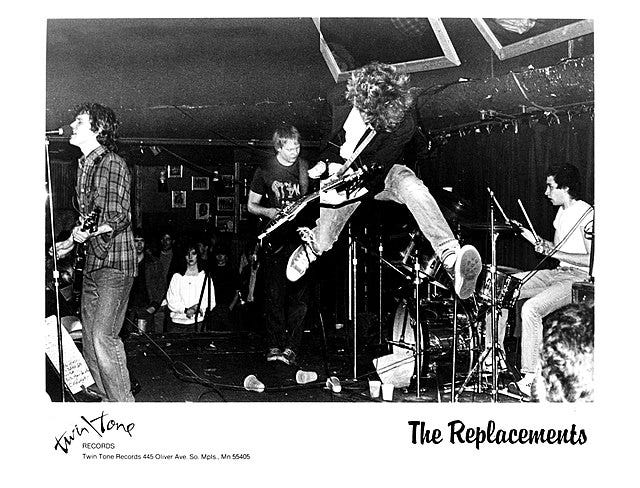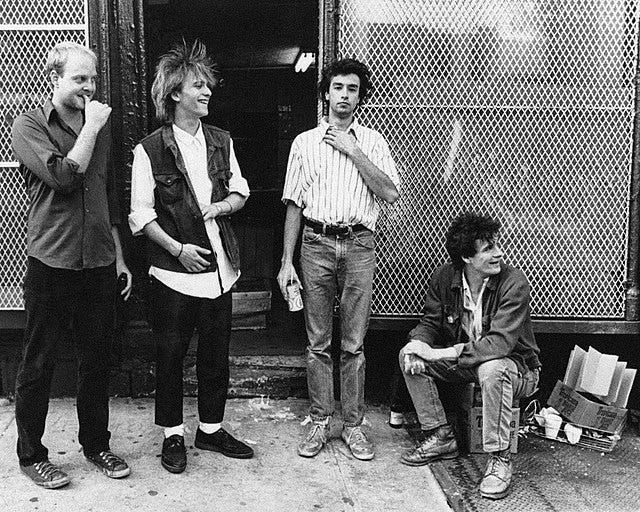The Replacements: A Lesson in Nonconformity
The Replacements, 1983, Twin Tone Records publicity photo; left to right – Chris Mars, Tommy Stinson, Bob Stinson, Paul Westerberg.*
Seen your video –
That phony rock ’n’ roll!
We don’t wanna know –
Seen your video!
We are in new territory when it comes to music-listening. In particular the way we interact with and discover music has completely shifted. The impulse to revisit and recycle what we know is particularly pronounced, with apps able to shuffle and re-shuffle our listening experience into an infinite echo-chamber of comfort. Moreover, for artists there’s an algorithm-led pressure to keep up and produce the latest viral hit on Instagram or TikTok, conforming to trends and fads. It’s quite a suffocating set of circumstances. But this is not a unique feeling, and indeed it can even be said to relate back to an earlier time in music-history when things felt equally stifled, overly-processed, and commercialised.
In late seventies Minneapolis, Paul Westerberg was feeling similar pressures, and took it upon himself to be part of an uncompromising reaction. Alongside “a janitor, a crazy drunk, and a little kid” (Chris Mars, Bob, and Tommy Stinson), he formed the Replacements (aka ‘the Mats’), a band which would go on to participate in the growing punk and alternative scene which had swept into the Twin Cities. The music of the Replacements is perhaps the prime example of a band who kept up a continual struggle against conformity and cohesion. Though it would result in the undoing of group, there is a lesson to be gleaned today from how the Replacements embraced unprofessionalism, allowing it to inform their music and identity.
The band’s earlier albums (Stink; Sorry Ma, Forgot to Take out the Trash) are a reflection of a pure, punk sentiment. Bob’s guitar slashes through the tracks, cutting past Paul’s nascent, screaming lyricism. Still, tracks like ‘Kids don’t follow’, ‘Go’ and ‘Johnny’s Gonna Die’ show an early urge in the band to invent beyond tracks such as ‘F*** School’ and ‘Customer’. It’s with the advent of their second studio album Hootenanny that the Replacement’s genre began to shift. Tracks like ‘Loveliness’ yield a Minutemen-like art-punk style, while in ‘Color Me Impressed’ and ‘Within Your Reach’ we finally see their distinctive alt-rock sound forming. However, to paraphrase Robert Christgau, it’s their final album with Twin Tone Records, Let It Be (1984), where the music just becomes something else. It’s a slender package – only 33 minutes long – but with good reason. Every track is balanced against the last: songs which master their earlier sound (‘Gary’s Got a Boner’, ‘Tommy Gets His Tonsils Out’) are accompanied by slower, pensive tracks (‘Androgenous’, ‘Sixteen Blue’), genre-resisting efforts (‘Answering Machine’), and deeply emotive pieces which hit like sledgehammers (‘Unsatisfied’). What ties the album altogether is an awkward, romantic, but self-deprecating tone. It’s summed up best in the opening lyrics to ‘I Will Dare’, a song considered by many to be the band’s greatest contribution:
How young are you? How old am I?
Let’s count the rings around my eyes.
How smart are you? How dumb am I?
Don’t count any of my advice.
Meet me anyplace,
Or anywhere, or anytime, now -
I don’t care, meet me tonight!
If you will dare, I will dare.
1986’s Tim continued this new direction, with loud anthems (‘Bastards of Young’), Westerberg alternative classics (‘Hold My Life’, ‘Kiss Me on the Bus’), and melancholy ballads (‘Here Comes a Regular’ – a track covered brilliantly by Phoebe Bridgers). But something also generally agreed upon is that the albums that came subsequently could never build on to Let It Be, nor arguably even Hootenanny and Tim. With the possible exception of some tracks here and there on ‘87’s Pleased to Meet Me (‘Can’t Hardly Wait’, ‘Alex Chilton’) and 1990s’ All Shook Down (title track, ‘Satellite’), the Replacements could never quite recover their early brilliance. The common denominator in this, consistently pointed out, seems to have been the departure of Bob Stinson as lead guitarist in 1986. Not to disparage Slim Dunlap who followed – bringing as he did something new to the band (mainly drugs, Paul joked) – but with the loss of Bob’s intricate riffs and solos the Mats could never again properly marry their sound with Paul’s lyrics.
1982 Twin Tones promotion, performing at Duffy's in Minneapolis, Minnesota.*
An anecdote tells of how that the nickname ‘the Mats’ came from a certain insulting bastardising of ‘the Replacements’ as ‘the Placemats’, which fans then affectionately appropriated. Speaking of placemats, this year’s re-release of the 1985 Tim record (Let It Bleed edition) is a nice way-in, an entry album for the uninitiated (but I’d say start with Let It Be as well). A new mix by the Ramones’ Ed Stasium, this year’s release is pure thrill from start to finish. There’s something for veteran fans too, with the opportunity to discover the unheard, sometimes acoustic versions of the tracks which defined Tim and Pleased to Meet Me. ‘Left of the Dial’ is a personal favourite of mine from the former. It’s a love song written to Lynn Blakeley (a guitarist Paul met briefly while touring), but it also works as a powerful ode to the fleeting college-radio scene and those evanescent bands who never broke out:
Pretty girl keep growing up,
Playing makeup, wearing guitar!
Growing old in a bar –
You grow old in a bar.
Headed out to San Francisco,
Definitely not L.A.!
Didn’t mention your name.
Didn’t mention your name.
There’s a lazy and cynical impulse going around, labelling followers of bands like the Replacements as ‘hipsters’ or ‘wannabe-alternative’ types. It’s an attack on those characters who say things like, “Oh, they’re quite underground, you won’t have heard of them.” But, personally, having interacted with the viewpoints of Mats fans, there’s never been an indication of this kind of snobbishness or gatekeeping. The 2011 documentary Color Me Obsessed by filmmaker Gorman Bechard is a superb account of the band’s history and its deeply loyal base of fans. Sure, there’s the cliché remarks (‘the best band of all time’), but there’s also fiercely honest remarks about how the band was the best at representing those who felt unrepresented. On the one hand, there was the ammo the Mats provided against a generation of real, patronising snobs who pitied ‘80s kids for having never experienced Beatlemania; and on the other, there was that deep connection which the band fostered with those who felt like outcasts. It isn’t about listening to a band which is ‘different’ or ‘forgotten about’, but about listening to a band that speaks to you whenever you’ve felt ‘different’ or ‘forgotten about’. The elements which undermined the Replacement’s mainstream success (their rampant alcoholism, the gender-bending attire and themes, the ironic and unserious live performances) were really their points of difference, their identity which fans related to. The Mats were icons of struggling youth, awkwardness and, yes, failure. They made it cool.
1984 publicity photo.*
For anyone not quite convinced of what I mean, there’s a brilliant podcast, No Dogs in Space, which covers the band’s history in five parts (including excerpts of influences, tracks, and live gigs). For those who are a bit more convinced, the definitive account of the Mats is probably the book Trouble Boys by Bob Mehr. Finally, for anyone in-between, I’d simply recommend giving this year’s release a listen.
Having tried to show how the band’s shortcomings made them brilliant, I hope I haven’t undermined the sense that they produced exceptional music. The lyrics which opened this article are from ‘Seen Your Video’, a track on Let It Be which satirises the advent of the MTV-style ‘music video’. It placed the band in an unpopular and pretty-much defunct school of thought (including Fugazi, Pixies, and Pearl Jam) sceptical of what Paul called ‘visualising the lyric’ The song is one of their best, showcasing Paul’s biting lyricism, perfect instrumentation by Tommy and Chris, and a particularly moving, unrelenting guitar riff from Bob. It sums up the band perfectly, and is best listened to as loud as possible. It is itself a mantra which we, as music-lovers or artists, should confidently adopt against conformist motivations: we’ve seen you videos, your phony rock and roll - we don’t want to know about it.
(*Image credits in order: Twin/Tone Records, 1983 - The Replacements (1983 Twin Tone publicity photo) [Online]; Twin/Tone Records, 1982 - The Replacements (1982 Twin Tone publicity photo at Duffy's) (cropped) [Online]; Levine, L., 1984. The Replacements (1984 Laura Levine portrait) [Online]; San Francisco: Wikimedia Foundation.)



